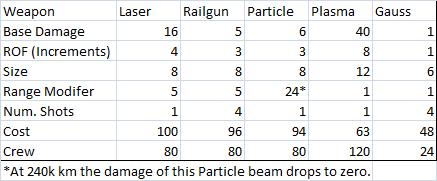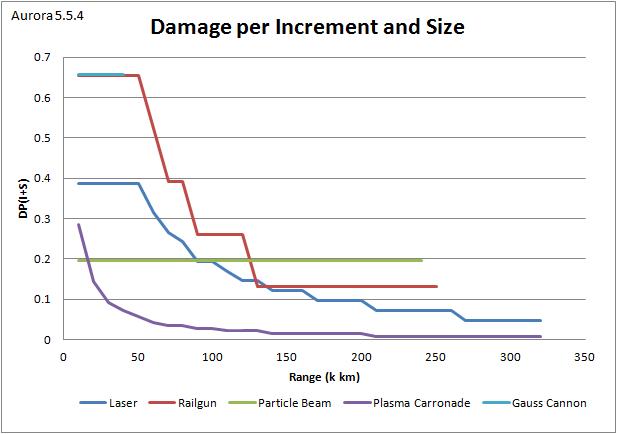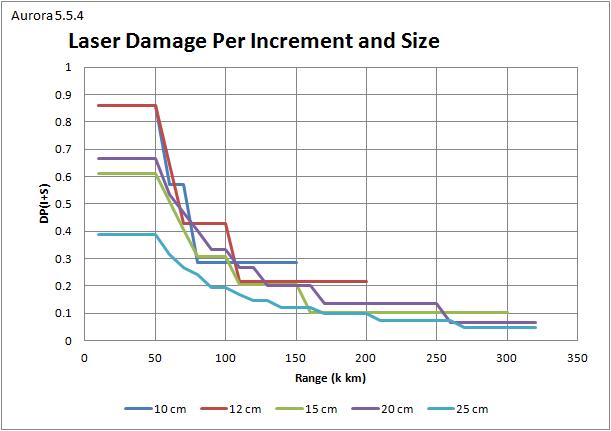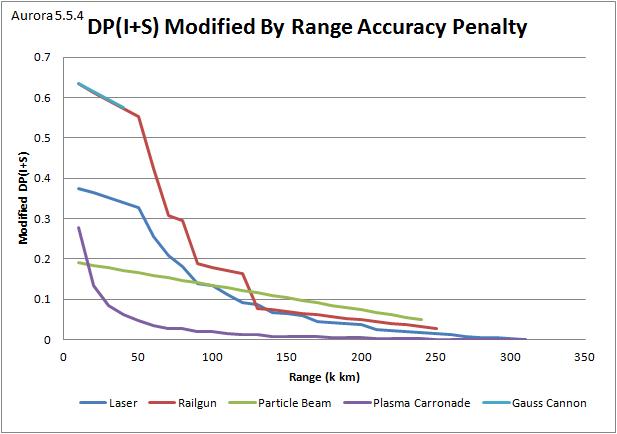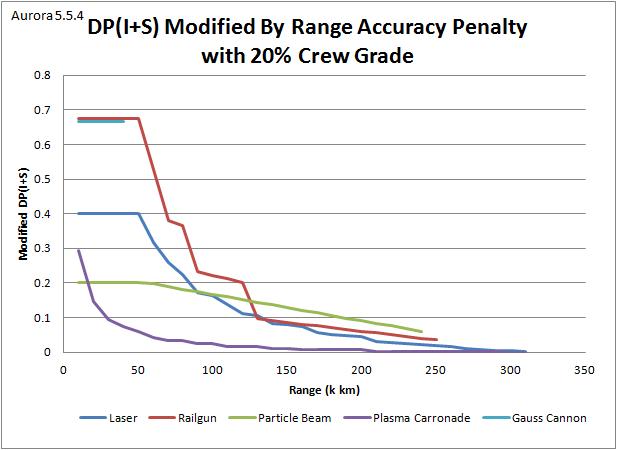Aurora is on version 2.5.0 C#, available at the Aurora Forums.
Contact Erik on the forum for a wiki account.
Beam Overview
This page provides a brief overview and comparison of Beam Weapons and CIWS. Beam weapon in Aurora refers to every weapon that isn't a Missile weapon or CIWS, and are operated by a beam fire control sensor.
Overview
Beam weapons are very short-ranged compared to missile weapons but they can do a lot of damage in a short space of time and they don't need ammunition. Beam-armed ships can be deadly when waiting in ambush at a jump point. Every ship suffers jump shock after a jump and a beam ship can do a lot of damage in that time, if it is experienced enough to respond to orders quickly. Additionally, Atmosphere reduces beam weapons damage (except mesons), so beam weapons will not work on or against bodies with more than 1 atm, for example Earth.
Beam Weapons are designed components. Each component has several background technologies that can be set independently to configure a weapon for the desired cost-benefit balance. The balance between different weapons will vary as they all advance. In any event, Aurora is very situational and often you need the right weapon for the situation. There isn't a 'best' weapon for all circumstances.
Lasers
Lasers are long range beam weapons and their damage drops off with range. They can be mounted in turrets for point defence use.
Railguns
Railguns shoot four projectiles at once and their total damage is approximately one third higher than a laser of similar technology. The damage falls off in the same way as lasers and their range can be extended by researching Railgun Launch Velocity. Because each shot does less damage than the total damage of an equivalent laser, the range is shorter and the damage is spread across the armour rather than penetrating in a single area. The range differential may not be an issue though if you don't have the fire control technology to take advantage of the laser's greater range. Although railguns cannot be mounted in turrets, they are still often used for point defence at lower tech levels because their high rate of fire compensates for their inaccuracy against fast moving targets.
Particle Beams
Particle Beams are a fixed damage weapon and therefore cause the same damage across their entire range. The technologies researched for particle beams are Particle Beam Strength, Particle Beam Range and Capacitor Recharge Rate. This is a fairly long range weapon, although not quite a long-ranged as lasers, and will out-damage lasers at its maximum range. A ship armed with particle beams should attempt to engage at longer ranges against other beam armed ships to take advantage of its fixed damage, while enemy damage decreases with range. This is a pure anti-ship weapon and would perform badly if used as a point defence weapon. It cannot be mounted in turrets.
Meson Cannon
Meson Cannon inflict only one point of damage over their range, which is approximately half that of an equivalent laser, but that damage ignores shields and armor. Like lasers, the range can be extended, in this case using Meson Focusing Technology. Meson cannon can be mounted in turrets for point defence use and are quite a popular choice, partly because they are ideal against an opponent who uses armoured missiles and partly because they are a very good anti-ship weapon at point blank range.
Gauss Cannon
Gauss Cannons are primarily a point defence weapon and in that role their performance is superior to the other weapons under most circumstances. They inflict only one point of damage but fire several shots per volley. They can be mounted in turrets and on a full size ship it is unusual to see a gauss cannon that isn’t turret mounted. Their background technologies are Gauss Cannon Rate of Fire, Gauss Cannon Launch Velocity and Gauss Cannon Size vs Accuracy. Unlike other beam weapons, there is no 'larger' version with a greater focal size. The max gauss cannon size remains 6 HS. However, you can reduce the size of the gauss cannon, while retaining its rate of fire, at the cost of reduced accuracy. This makes it useful as a weapon for very small spacecraft such as fighters. In a fighter vs fighter engagement the low damage output of the gauss cannon is offset by the fragility of the target. Another advantage of the gauss cannon is that it does not require reactor power in order to fire. It will always fire every 5 seconds.
Plasma Carronade
The Plasma Carronade is a high damage, point blank range weapon. It has only two background technologies, Carronade Calibre and Capacitor Recharge Rate, and there is no way to enhance range beyond increasing the damage output. The calibers available are larger than those other beam weapons at a similar tech level so this is usually the weapon with the highest damage at close range. If you are outclassed technologically then build a ship with a few of these and wait for your opponent beyond a jump point. It cannot be turret mounted and is far from ideal as a point defence weapon.
High Power Microwave
High-Powered Microwave (HPM) is similar to the meson cannon in terms of design, in that it causes only a single point of damage and uses components such as HPM focal size, HPM focusing and capacitor recharge rate. The range of the HPM will be the same as a meson cannon with the same level of technology. However there are two important differences:
- ) The High Power Microwave is not affected by armour but it is affected by shields. However, because of the HPMs effectiveness against shields and electronic systems, the single point of damage from the HPM causes three points of damage to shields.
- ) Once the shields are down, the High Power Microwave only damages systems classed as "Electronic". This currently includes sensors, fire control systems, ECM and ECCM. The HPM is designed to blind an enemy rather than destroy him. Each class has a separate "Electronic Only" Damage Allocation Chart (shown below the normal DAC), which is used by the HPM
The HPM can be a powerful weapon. Although it causes no damage to the majority of a ship's systems, it can damage shields and then blind the enemy, either forcing him to retreat or rendering him vulnerable to more destructive weapons. It is also quite expensive, costing twice as much as a similar size Meson Cannon, and difficult to employ effectively because of its relatively short range.
Close in Weapons System (CIWS)
CIWS, although it is not strictly a beam weapon in the general sense, this is a good place to introduce the CIWS, or Close-in Weapons System. This is the Aurora equivalent of the Phalanx or Goalkeeper systems that protect modern warships. It's a little complicated as it uses several different existing systems to create a single installation. The restrictions on its use are that it can only protect the mounting ship (other point defence weapons can protect other ships within their range) and it can only be used to engage missiles. The components of the CIWS are calculated as follows:
- ) The basic system is a dual half size gauss cannon. As the range is limited to 10,000 km, I have reduced the size slightly from 6HS to 5HS. As it is a dual mount, the rate of fire for the system with therefore be double the racial gauss cannon rate of fire
- ) The integral fire control system is assumed to be a 4x speed installation. The normal 4HS size is then divided by (maximum racial fire control range / 10,000) as the CIWS requires a max 10,000 km range. Finally the resulting size is halved to account for the fact this system can only defend the mounting ship, which makes things a lot simpler.
- ) Turret gears are added using the normal rules for turrets with a tracking speed equal to that of the above fire control
- ) The integral active sensor uses the size that would be required for a resolution-zero installation with a range of 30,000 km. This is longer than the max range of the system but it needs a little tracking time. Note that this is not an active sensor that will detect anything else. It is purely a point blank range missile tracker.
- ) If ECCM is available, it can be added to the CIWS and will use 0.5HS. As this is a reduced-sized system, it will have half the capability of the regular system
- ) As the gauss cannon are half size, the base chance to hit for the CIWS is 50% (modified by missile speed, crew grade and electronic warfare). This is actually slightly higher than it would be for a half-size gauss cannon with a short-range fire control but I am assuming it fires at even shorter range than other anti-missile systems.
- ) The cost of the system is based on the cost of all the individual components
You don't need to allocate point defence modes to the CIWS, allocate ECCM or allocate weapons to fire control systems. It is a fully integrated, fully automatic system. If a missile is about to hit the ship, it will open fire. Here is an example CIWS using components up to 8000 research points. I'll work through the steps and then show the completed system
- ) Dual half-size gauss cannon with a ROF of 3, which equals 6 shots in total. Size: 5 HS.
- ) Fire control system (tech 4000 km/s). This 4HS system has a tracking speed of 16,000 km/s. As the racial fire control range is 32,000 km/s, the fire control size is divided by (32,000 / 10,000), which is 1.25 HS and then halved to 0.625 HS
- ) Turret gears (tech 5000 km/s). As per the normal rules, the gear modifier = (FC Tracking Speed /Turret Tracking Speed)/10 = 0.32. Multiplying this by the weapon size of 5HS, gives a turret gear size of 1.6 HS.
- ) Active sensor (tech strength 21). A 1 HS active sensor with resolution zero would have a range of 210,000 km/s. Therefore a range of 30,000 km/s requires a sensor size of 0.1429 HS.
The CIWS is intended to be added to non-escort warships as a last-ditch defensive system. It allows the designer to add a self-contained anti-missile system without having to worry about anti-missile-oriented sensors and fire control systems and the player doesn't have to be concerned with allocating weapons or fire control systems. They are of little use for escorts though as they can only protect the ship that mounts them. CIWS are classed as non-military as they have no offensive capability and therefore you can mount them on commercial vessels.
Graphical Comparison of Beam Weapons
The following is an analysis of the beam weapons which have typical damage profiles, ie everything other than Mesons, which bypass shields and armor, Microwaves, which deal electrical damage, and CIWS, which are not offensive.
Also see Beam Weapon Range.
These are the relevant stats of each weapon system examined:
These weapons were created with reasonably early technology, but there has been some research along each line to give them a chance to grow into their strengths a bit. A more thorough examination would also look at a set of weapons later on in the game to make sure their balance is similar then as well. This is the amount of technical research used to attain each set of weapons. Each system got as close to the same amount of research as was possible.
Now lets start getting to the meat of the matter.
The first step is to look at pure damage per shot of a single weapon. This gives you a really good picture of the dynamics of the different weapons. First you have the Plasma Carronade, putting out an immense amount of damage with each shot that dissipates very quickly. The next highest damage level is the Railgun, which overpowers the laser with its four projectiles. As each of the projectiles’ damage dissipates with time, however, the damage level drops below that of the laser at longer ranges.
Next you have the laser, which does medium damage that slowly degrades over time, then the Particle Beam, which does constant damage which starts to surpass all other weapons at the mid-long range. Lastly comes the Gauss Cannon, which at this tech level fires four shots of damage one (constant for all tech).
So that’s all well and good, but that’s only part of the picture. Since armor and the penetration thereof is such a big part of the battles in Aurora let’s look at that next:
Since the Plasma Carronade has the least penetrating damage template and the laser has the most penetrating one, they are actually penetrating the same amount right from the start, even though the plasma gun does way more damage! Then, as range increases the penetration of the Plasma gun drops far faster than that of the laser. Next you have the Railgun and Particle Beam. While they each share the same damage template the fact that the Railgun’s damage is spread out amongst four shots means that they penetrate the same amount of armor regardless of their increased damage.
The big takeaway of this graph is to note that the advantage of the Plasma Carronade that seemed so enormous in the last graph isn’t as large as it appears, even at the smallest range.
The next step is to stop looking at individual guns and individual shots, but instead look at how many of these guns we can put on a ship, and how often they will fire. To do this I ignored Beam Fire Controls, since you can use many weapons on one Fire Control. But I did add the mass of the gun to the mass of the crew quarters needed to house the gunners, and the mass of the reactor of this tech level that would be required to power it (no power/stability boosts or penalties), I divided the damage by that hull size, and by the number of time increments it would take to fire for the Capacitor Recharge Rate of this tech level.
Now things start to look different indeed. The immense first blast of the Plasma Carronade is not followed by another shot for quite some time, and the weapon is larger than any of the others. The laser has a much higher DPS than the Plasma Carronade, and the same or better penetration. These adjustments have also made a big difference to the Railgun, further increasing its lead over the laser in close quarters. If you look closely you’ll see that the Coil Gun has done tremendous as well, helped along by its quick fire rate and lack of a reactor. Even with terrible armor penetration you could do worse.
For some background for the mechanics of that last slide: as the focal size of the various weapons increases, their total size increases roughly linearly as well. However their damage increases (even more) roughly by the square of the size, so you start getting a lot more damage per hullsize. At the same time though the power requirement is directly tied to damage dealt, so your fire rate is falling at the same time your damage rate is rising. When you add in a larger gun your DPS actually drops over time. The changes buy you two big things though. First of all, with higher damage comes higher penetration, this is the main benefit. It also entails higher resistance to range degradation, so though your Point Blank DPS drops significantly, your DPS at higher ranges isn't affected as much. At the higher range the larger guns have almost caught up from a DPS standpoint, so they are equal except with regards to their better penetration. As an example of this mechanic, take a look at the DP(I+S) of all of the sizes of lasers unlocked at this tech level:
We are definitely closing up on the end here, but for thoroughness let’s take a look at another mechanic. As range increases not only does the damage of most of your weapons directly degrade, but you also get a penalty of all beam weapons to your accuracy. What do these graphs look like if you take that into account?
Once you start taking account of those misses at longer distances you get a steep damage drop off. This is a useful chart to see because you can look at this and decide whether having longer-ranged beam weapons is that appealing to you. You may decide that you’re ok with doing less damage at 200k km because you are going to want to do all of your fighting at 50k km where all beam weapons do more damage, and the Rail Gun really shines. (Keep in mind the Rail Gun’s lower penetration though)
With the bonus to damage by being in close you may wonder why you’d ever fight at range, and it really just depends on who you were fighting. If they have no beam weapons then you can close as you wish, but if they have Plasma, or Railguns, or especially Mesons it becomes much more dangerous to close, and having the longer range weapon may help you completely avoid damage from those weapons.
The above graph doesn’t tell the whole story of the accuracy penalties, because the skill of your crew—called the Crew Grade—provides bonuses to the accuracy of your beam weapons. For example, a 20% crew grade bonus would turn an 80% chance to hit into a 88% chance to hit. If you have a relatively skilled crew with a Grade of 20% then the above graph is changed to look like this:
So with a skilled crew you aren’t going to have as much of a penalty at range, and that penalty will start later. Skilled crews also have other benefits: faster missile launches, quicker response to orders, faster recovery from jump blindness, lower chance of components breaking during maintenance checks, and more.
Spinal Mount
(v6.30)
Spinal Lasers are larger weapons than could normally be constructed using available technology. A ship can only mount one spinal weapon and they cannot be mounted in turrets.
To specify a weapon as a Spinal Weapon, select an option under Energy Weapon Mount. The possibilities are Standard Mount, Spinal Mount and Advanced Spinal Mount. The latter two cost 5,000 and 20,000 RP respectively. A spinal mount uses a focal size 25% larger than the maximum possible for a normal laser. The Advanced Spinal Mount uses a focal size 50% larger.
Notes
- See also Summary of Beam Weapons and CIWS tutorial.
